
2023 Tata Nexon: Punching Above!
- Sep 6, 2023
- Views : 6238

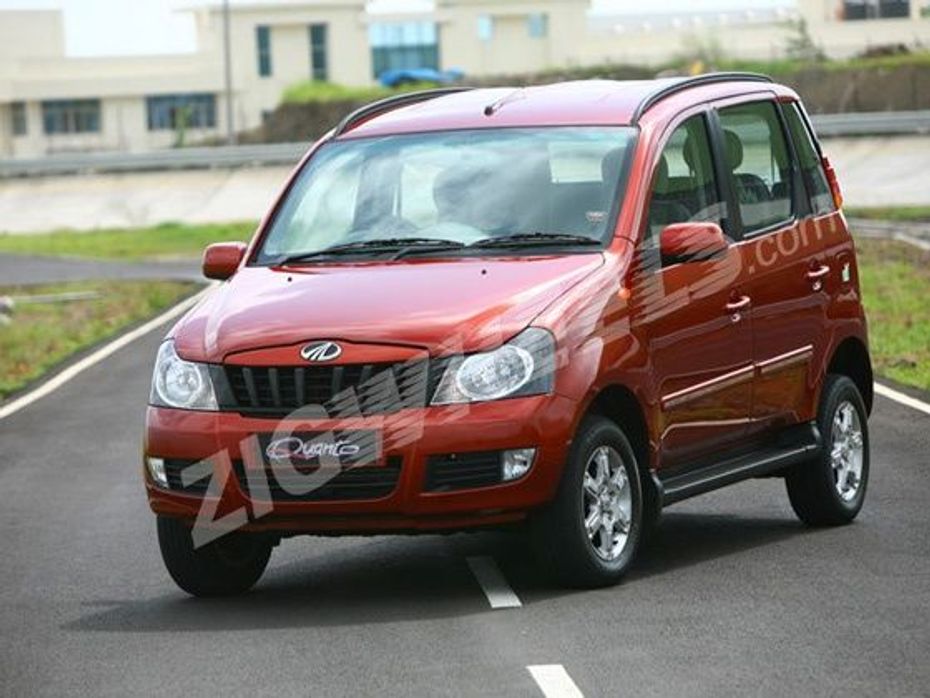
Ever since the talk began about a small sized SUV from Mahindra and Mahindra, it was always about a mini-Xylo and in this mix-up of terminology, MUV and SUV, I think many lost out on the fact that while M&M is better known for UVs, with a growing number of SUVs in its portfolio, the Xylo was its most modern MUV and stays thus to this day. However, right from the design stage this vehicle had been the subject of a load of planning across the spectrum. Not just the engineers and the designers plus also of course the bean counters but more importantly the product planners were seeking to see how they could get two or three models from the Xylo base. The imperative was to think and play smart given the investments made and this approach showed an all new facet of the company – its intent to grow up and think like any main stream MNC OEM. Albeit with a difference, of course!
And it is this differentiation that has seen the new vehicle, termed the Quanto, come up as an all new fresh face to all those who have their eyes on a large hatchback yet could be lured by the myriad pleasures of an individualistic all-Indian offering. In the process as you get to see the form and the proportions, it has also emerged as Mahindra’s very own tall boy but better placed on its wide 1500mm track (front and rear) and 2760mm wheelbase – dimensions its shares with its larger and elder Xylo sibling. However it is in the manner that the rear end portion has been lopped off and as many distinctive elements of the original Xylo retained while yet giving the Quanto a nearly different wholesome identity that this vehicle stands out to maybe spawn yet another new segment in the Indian car market. Also Read: Mahindra Quanto launched; prices starting at Rs 5.82 lakh
Form follows function!
Let’s first get to grips with the form and then let the function follow. The most obvious trait of the original Xylo was in its body-on-ladder configuration, an area which has been at the base of it all since the original Jeep CJ3 from 1954. However, the Xylo broke new ground in the ladder-type chassis being an all new development and much of this has been adhered to in the Quanto barring off course the shortened rear portion. Much of the suspension bits are as they were on the Xylo, the double wishbone independent set-up in front and a five-link set-up employing coil springs at the rear. These bits have been further tuned and re-calibrated given the nature of the vehicle, its intended application and load, the lighter engine up front, the different tyres and also the weight distribution. However, the clever bit is all about the sheet metal and how effectively the same side door frame from the front fender onwards till right behind the C-pillar has been employed in toto thereby saving big on any new tooling outlay for the same.
The bonnet is a straight lift from the Xylo as are all four doors though the vehicle doesn’t give that aura on first look. The smallish and almost triangulated rear quarter window makes a for a nice wrap around package integrating the vertical tail lamp cluster on the D-pillars and the large rear windshield. Probably the most distinctive element of the Quanto part from its stance is the fitment of the spare wheel on the tailgate and thereby hinting at its maker’s DNA to some extent. The pronounced wheel arches, the character strake just below the belt line running from front to rear (wrapping across the tailgate as well and on to the other side) plus the full length floor boards on either side are again familiar accents but they do work well with the overall proportions and form.
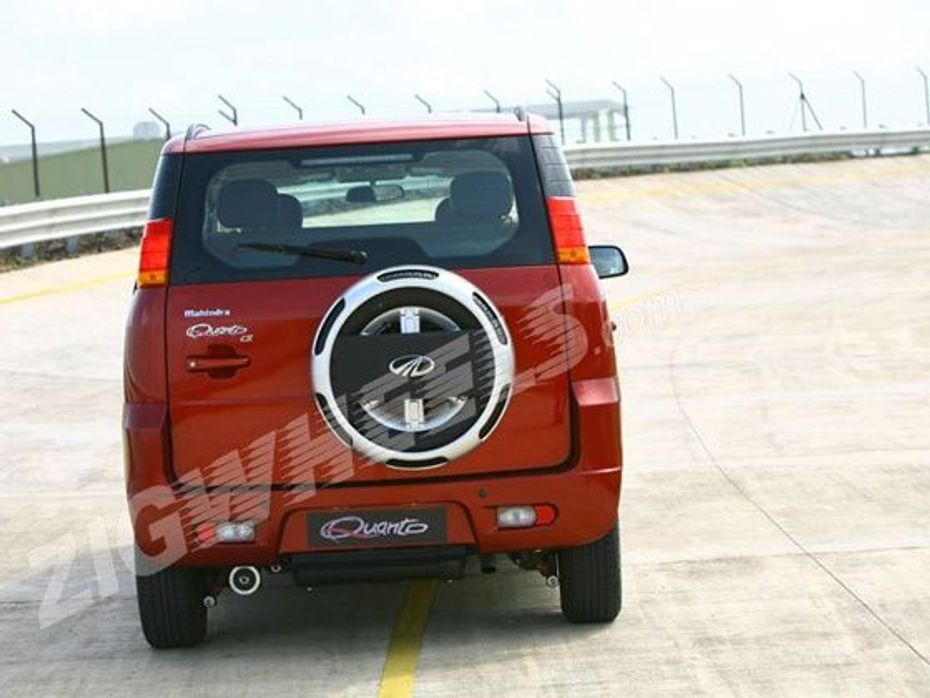
Maybe the biggest disappointment of the Quanto, in case we are mentioning design and style is the near identical front end which clearly symbolises the Xylo. For an all-new car, given the complete mastery of their cause, Dr Goenka’s team has maybe faltered in not giving it a whole new identity up front where it matters. However to take the good doctor at his own word, he did inform me that the plan was always to craft a mini-Xylo and therefore the design language to the original was adhered to. It was however only in the last few months as they neared series production did it dawn on them that maybe they could treat this as an all-new product and position it differently from the Xylo. However, to have delayed the launch was an impossible aspect while the time to craft a whole new front end was inadequate but the product development team is already working on not just a completely new front end but also a few more bits which should make the Quanto stand out on its own even more emphatically. Also Read: Mahindra Quanto Special Coverage
That said, the toothy grille (almost Korean-inspired might I add) seems to be a speciality thrown in to link the Scorpio to the Xylo and on to the Quanto but this tenuous link has maybe run its course and it could just be the last manifestation as such on a Mahindra as we move forward. However, the overall proportions of the Quanto are far more pleasing than that of the Xylo I might add and while pictures might not bring it to life in a punchy manner as it does in the flesh, it nevertheless makes a case for itself as a terrific alternative to the large hatchbacks dotting the Indian car landscape. The stance is everything and with virtually next to no body overhangs front and rear, the adherence to the stylish six-spoke 15-inch wheels shod with slightly smaller section tyres (205/65-R15 instead of the Xylo’s 215/75-R15) helps give it a more planted appearance which also hints at subtle muscle and strength which no hatchback has been able to muster. Also the ratio of glazed surfaces to sheet metal works out well in an equitable manner on this car and this further underscores the well defined tall boy look rather than an ungainly glasshouse on a meagre base.
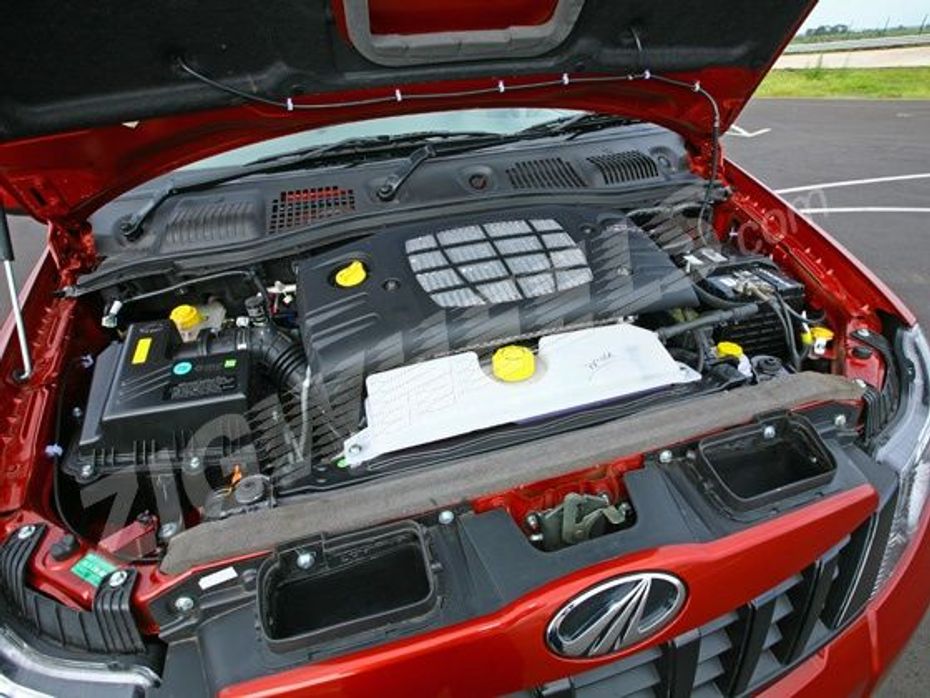
Heart of the matter – the new triple pot diesel engine
Clearly the heart of the matter is of course what moves the Quanto and in extension how it will move hearts and minds. Clearly to have given this vehicle the Xylo’s large mEagle 2.5-litre mill would have been an overkill and also made it pretty unwieldy but here again a complete new thought has prevailed. While all over the globe there is the talk about sustainability and also down-sizing to go along with it, Mahindra has proved here with the Quanto that it can walk the talk by letting its actions prove it so. Dipping into the mHawk engine family which as we have already seen in its first 2.2-litre manifestation, the Mahindra boffins have come up with a three-cylinder inline unit displacing 1493cc.
This is the first three-pot unit from an all-Indian car maker and while it does feature Bosch common rail direct injection what distinguishes it differently is that it is also the first in the country to employ a dual-stage turbocharger (supplied by Borg-Warner) to help it spool up to speed in the low revs and give it that initial torque thrust which is so demanding of our traffic conditions. Badged the mCR100, the m standing for Mahindra, CR for common rail and 100 being the output in bhp, this unit is mounted in a north-south location and drives the rear wheels via a five-speed gearbox which is a slightly tweaked derivative of the same unit employed in the Xylo. Of course overall gearing has been revised to compensate for the different profile rubber employed and also the overall torque characteristics but by and large these were not major changes over the already proven aggregates and accomplished all in-house within the MRV set-up at Chennai.
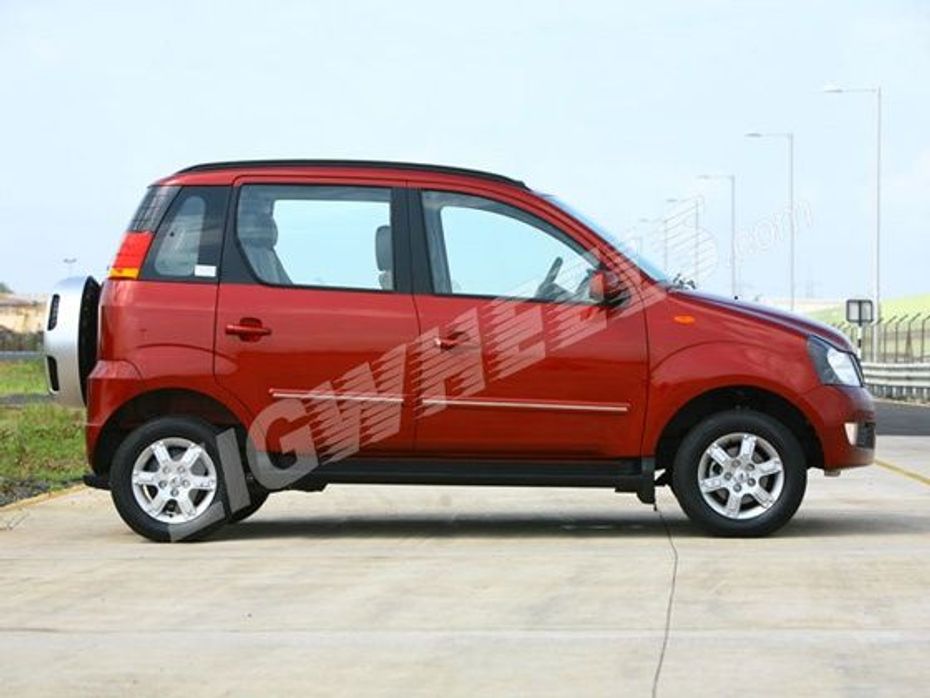
There of course were big challenges because unlike the larger Xylo where the NVH learnings from the Scorpio were further refined and adapted, the three-cylinder engine with its inherent low end low frequency vibes has also been a major challenge for many automakers. More so a diesel with its inherent large shakes at start-up. So while the first thought was to try and give it good mounts all around (there are hydraulic mounts locating the engine on the chassis) and also an engine damper there is still quite a degree of vibration which manifests itself at start up and also when you go off throttle in the lower gears.
I quizzed Dr Pawan Goenka on this aspect and he confirmed that this is an area which is most challenging and his team are working on curing this inherent low end vibe which I am sure is no more or less there is on other diesel-engined vehicles with body-on-frame configurations. However, given the fact that the Quanto would be battling the large hatchbacks with high levels of refinement, expect this issue to be sorted sooner rather than later. Maybe going to a dual mass flywheel could be one of the solutions as many others with three-cylinder diesel engines have found it beneficial in this area.

The mHawk engine family
In the course of our discussions with the Mahindra boffins on the engine side, we did come to know more on the mHawk family which now has two, three and four cylinder engines in its line-up. Cylinder dimensions of the triple are 83mm x 92mm giving it a swept volume of 1493cc. What Mahindra has done is to manage a whole new family of engines across the range keeping the bore centres common so that productionising them (on the engine machining line) becomes easier and efficient even though the bore and stroke of each one of them is different.
The four-cylinder mHawk employed in the XUV500 has bore and stroke measurements of 85mm x 96mm incidentally and the design thought in the engine department was to have the twin-cylinder engine displace 450cc per pot, the triple to go upto 500cc per cylinder while the each of the cylinders in the four would displace 550cc apiece. Given this line of thought, the new mCR100 engine develops 100bhp at 3750rpm and whips up a stupendous 240Nm of torque in the 1600-2800rpm band. This easily trumps the hot diesel hatches like the Hyundai i20, the Suzuki Swift and the Fiat Grande Punto but then these hatchbacks have a weight advantage over the Quanto effectively balancing the power-to-weight issue among them in different ways.
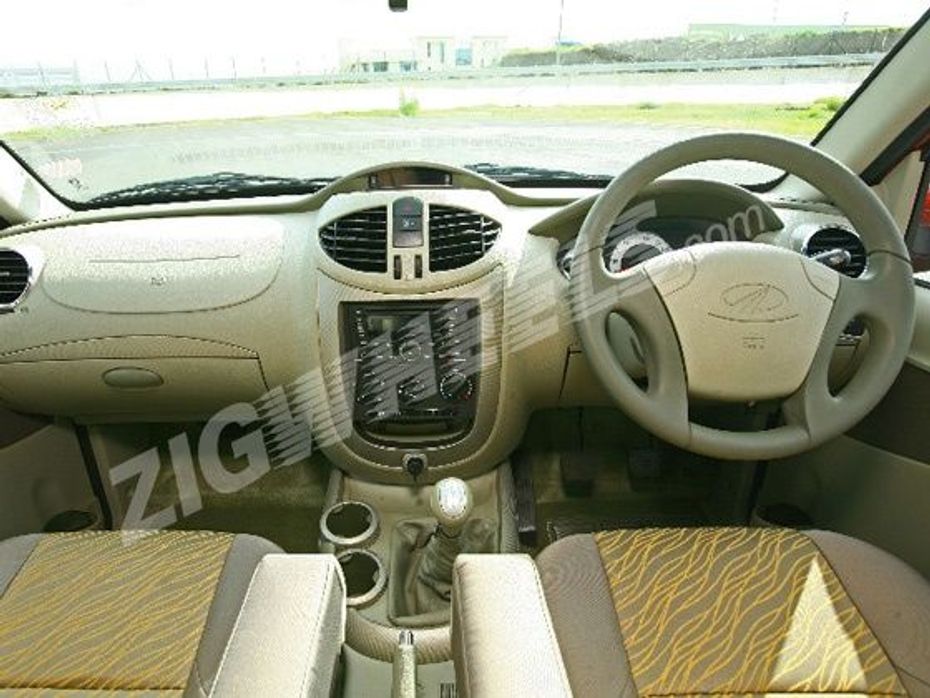
Step in to a world with a few familiarities!
The most obvious aspect after the mechanicals was all to do with the operating environment of the Quanto and as you step into the vehicle you find the same airy cabin which is a big plus to get going. The IP (instrument panel) or dashboard is a straight lift from the Xylo but it now comes with a new top panel and thankfully the purple-hued innards of the glove compartment have been banished!
Speaking of which there yet lurks purple where you least expect to find it: in the footwell area ahead of the front passenger seat you would notice the carpet has been slashed (in a proper manner of course) to gain access to the VIN plate which is riveted straight on the chassis rail which in turn is painted probably the same shade of purple as that which adorned the Xylo! I made a mention of this in passing to Dr Goenka who tellingly informed me that both me and him were getting old and that purple is the new age colour, even BMWs sport them with élan it seems, eeeks!
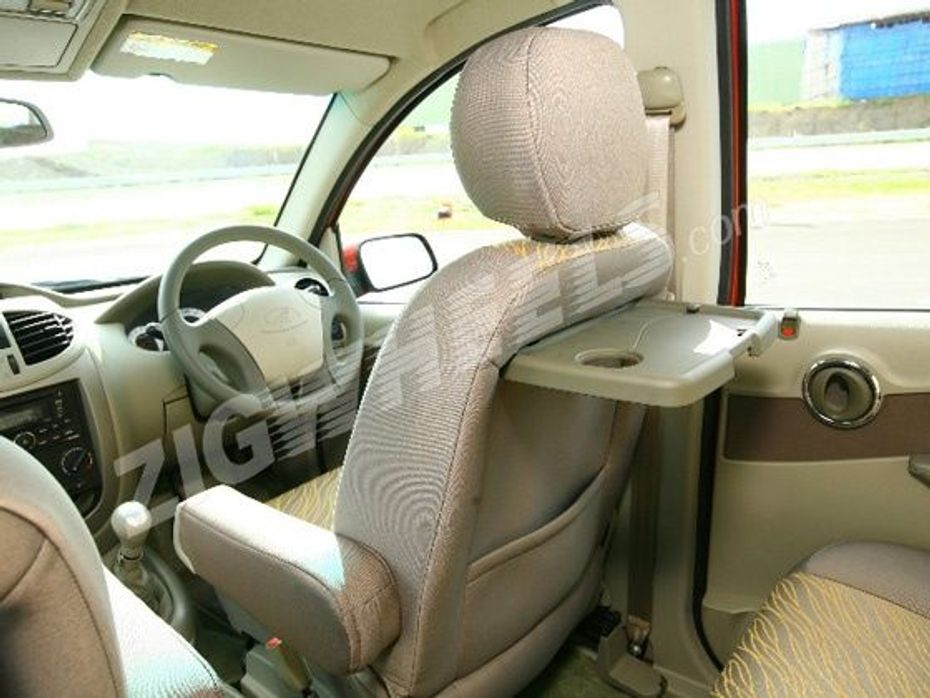
Just like I referred to the front end style being so very close to the Xylo, the same thought holds true for the dashboard as well and maybe this could also have been configured differently. Maruti Suzuki has a whole load of small cars in its arsenal, some overlapping each other but all of them have distinctive identities and dashboard facias to give them individuality and character which is such a strong point when it comes to making their presence felt in the showroom.
Maybe I might be a bit harsh on Mahindra & Mahindra but then this is only because the company has upped its game to such a high level in recent years that anything of this nature harks back to a bygone era. Of course, to again give them their due, the original game plan was to create a mini-Xylo but no one within the team realised how effectively they had spawned an all-new take and by the time realisation dawned on them it was too late to devise all new fitments. However, even as we speak new design details should appear within the next year itself, by which time the basic product would have found tremendous practical appeal amongst car buyers.

Versatile seating demands adjustability
Note the term ‘car buyers’ for this is exactly where the Quanto is destined to make its mark, as an absolutely worthwhile alternative to the hatchback brigade. The interior is large and comfortable and easily bests the whole load of hatchbacks there are in the market today but with one provisio. The middle bench seat is just that, a bench with a fixed back rest. While the seating position is comfortable and the H-points are well sorted out, given the manner in which the XUV500 was configured I for one expected to see if not a completely fold flat seat, at least a seat with a split folding back rest.
From the versatility point of view there is so much that is possible with the Quanto but the base has to have that mix of adjustability built within at the first go itself. The two perfunctory seats at the rear, sideways and facing each other, just like in previous Jeep models of yore, could be pressed into use if required in a cinch.
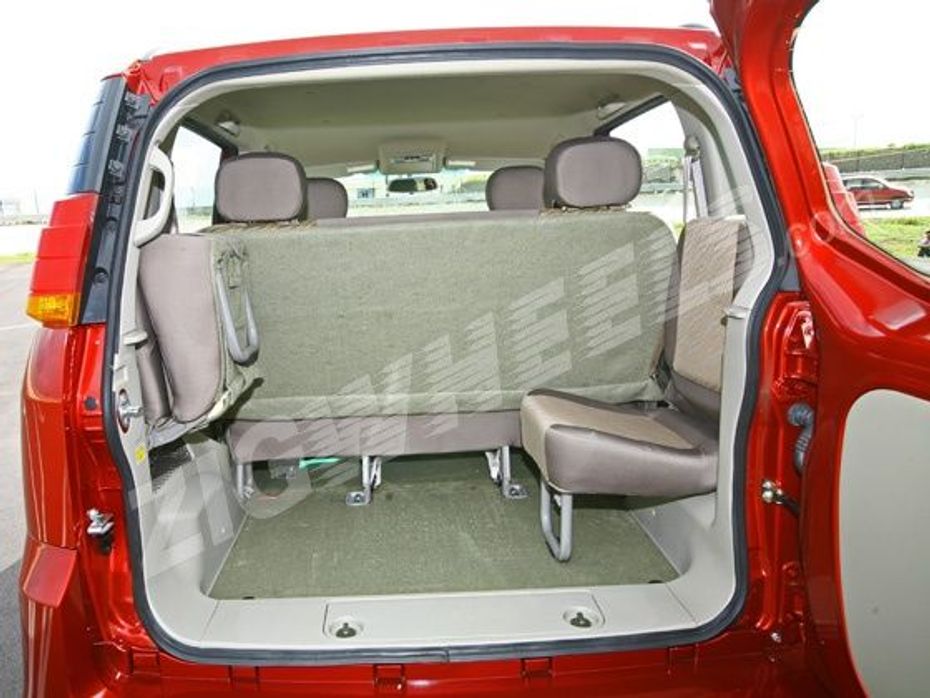
However this adoption to classify it as a seven-seater could be a big selling point and this could work to a great extent in semi-urban and rural areas which is fine but in the urban jungle and operating environment maybe Mahindra & Mahindra could look at even more comfort and space for the critical middle row seats and dispense with the last two seats completely. How this pans out on the taxation front (if there indeed is a tax benefit) remains to be seen but I am sure that a luxuriously outfitted 2+2 could be ideal foil for the Quanto to sport and flaunt!
Maybe there is a large market should there be the likes of Mahindra’s own speciality vehicles division or DC Design to develop hop up interior kits in a 2+2 configuration at a competitive price and I can see many queuing up for such a package right now itself! Also speaking about the present two fold-up seats at the rear, they do provide rudimentary seating for short distances but they are best used folded flat and the space liberated is fairly larger than any of the big hatchbacks can provide.
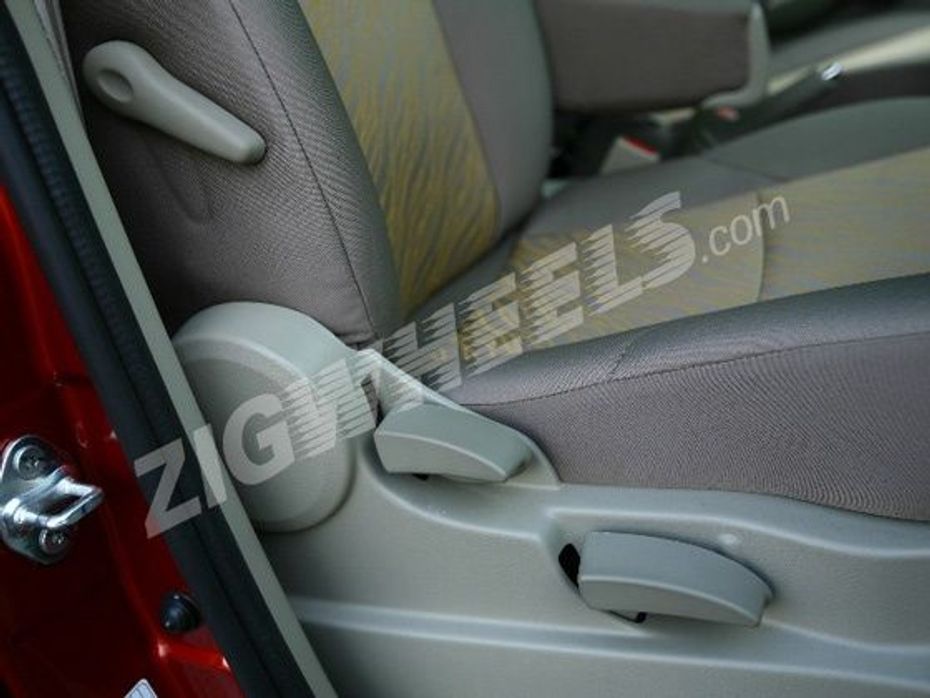
Ergonomics adequate but could have delivered even more!
Getting to the ergonomics of the cabin, the driving position is the familiar set-up from the Xylo and it is a much praised layout with comfortable posture and good peripheral vision for the driver to have a wide span view of proceedings around him. The control switches, the pedals, the gear lever and the steering wheel all play their own role in providing that essential tactility and also the inherent cohesive relationship between them as they are pressed into service. The instrument panel is all analogue and there is a central information console – Digital Drive Assist System in Mahindra-speak placed on the top of the dashboard which does its job of dishing out the gen on journey speed, temperature and fuel efficiency. Speaking about temperature and yes even with a smaller engine the HVAC system is pretty quick in cooling the large expansive cabin an then maintaining it for as long as you complete your drive. All this without a drop in the engine performance, clearly a sign where the hatchbacks do wail as they are found wanting.
Speaking of ergonomics, I found the ingress and egress for the rear door to be a bit tricky solely due to the fact that the middle bench seat has been placed just about far back so as not to interfere with the fold-up rear seats and just about delivering enough keen room to keep the mom-in-law happy on the middle bench! Yes there is a compromise here due to making it and classifying it as seven-seater but again it would be buyer who could make the decision to use seven or five seats. Problem is even is even if he wants to use five, he needs the adjustability to be built in and this is not there, as yet! The quality of the seat cushioning and the upholstery plus the overall cabin build quality is very good and there are no qualms on this front plus the fact that there are arm rests for both driver and front seat passenger, under seat trays for storage, bottle holders in easy reach for all and also a 2-DIN music system integrated into the dashboard, depending of course on the trim specified.

Like other offerings we have seen from Mahindra & Mahindra in recent years, the Quanto comes highly specced with ABS and EBD on the two top line versions along with air bags for both driver and front seat passenger. There is also the Intellipark Reverse Assist System with projector screen for the rear camera built into the cabin-mounted rear view mirror and many other details which indicate that a good deal of effort went into tailoring equipment for the breed of customer the firm wants to bag with the Quanto.

On the move and it delivers, in the real world!
This is about the most important aspect of any vehicle and the Quanto has the measure of so many other cars in different segments! I think the performance is more than adequate for a vehicle of its type and yet so very close to that of many of the large sized premium hatchbacks. The best thing is that the engine spools so quick that initial getaway is easy and simple and once slotted into third gear the thick torque streams into play and forward motion is terrific.
Mind you this isn’t a sports car or for the performance minded but I am sure she will delight with performance of the user-friendly kind: good driveability in-town, strong-legged capability on the highways, and with the ability to please where it matters the most, in the pocket! While we have not put the Quanto through the rigours of a thorough ZigWheels road test (will do so soon), the first drive proved that the car has the wherewithal to hit big on the operational cost front. In fact its makers claim that the vehicle would deliver consistently high fuel efficiency and the ARAI certified mileage is 17.21kmpl. For a car of its heft and weight (1640kg kerb weight) and engine displacement this is a pretty sound figure and I am sure that in these days of spiralling fuel prices, doing diesel is where the savings would come, more so in the upper recesses of the mind where perception rules the roost so strongly among our brethren.
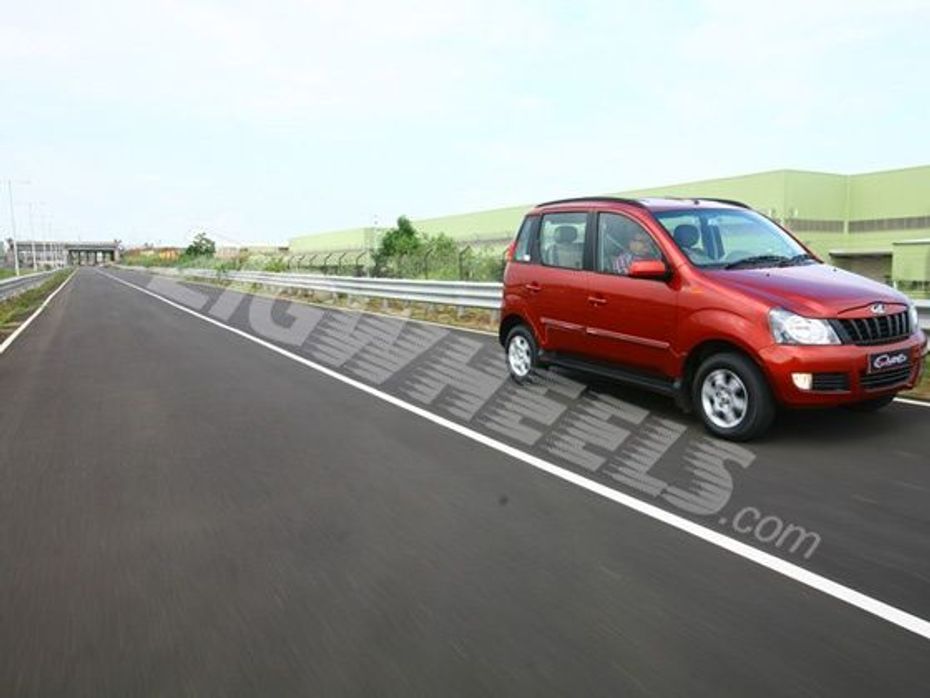
The wide track and the long wheelbase coupled to the overall firm ride and handling make the Quanto stay planted on terra firma even though it does display some body roll when hustled through corners at speed. However, the roll is pretty lazy and unexcessive given its tall boy stance and the stability afforded the driver and other occupants is top notch. When one understands that it was Lotus which helped in getting the Xylo’s ride and handling characteristics perfected to a fine pitch, I am sure the strengths from there have been wrought very well into this vehicle also.
The ride quality is terrific, probably the best if one compares it to any other hatchback but to some in the back and middle row seats would find it a tad on the firmer side. The Quanto steers well and has an ideally weighted steering which is perfect – not too quick nor too cumbersome, allowing it to be the quintessential good mannered car for the masses. Under braking the Quanto remains well behaved with not much weight transfer up front to unsettle the vehicle. If I had to crib about something it could be the slightly wishy-washy feel in the shift actuation which I am sure could be tweaked given that there is now a new linkage for the five-speed ’box as compared to the Xylo.
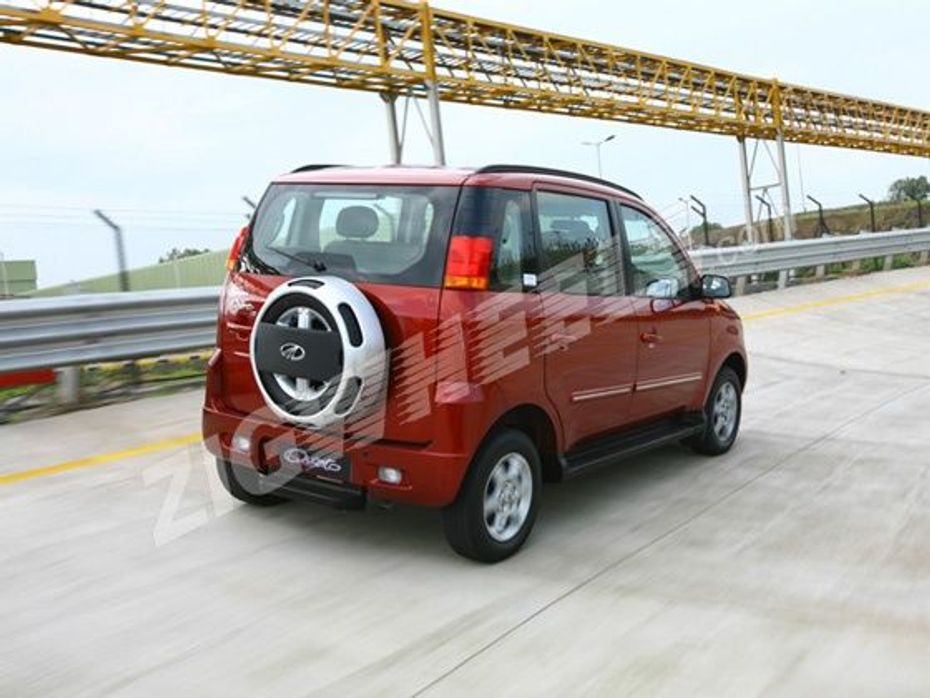
Price positioning is the key!
This is the trickiest bit for its maker and also for the Quanto’s acceptance by punters. Mind you this could change because this first drive and description story was written a day before the launch of the vehicle and we did not want to hazard any price indication but this becomes inevitable given that we are so close to launch. The focus area of such a clutter-breaker of a vehicle which is poised to be a worthwhile alternative to the mainstream will be poised on price to a great extent. Knowing the manner in which Mahindra & Mahindra has acted in this area with its last few products, I expect the Quanto to be devilishly priced to reap full benefits in the commercial space.
It has to be just right, not too low or too high and getting it spot on is even more precipitous than anyone can imagine. However, the XUV500 has shown what Mahindra can do in delivering a value-packed proposition and if I were to infer the same, one could be looking at a sub-Rs 6.00 lakh (or even lower) price tag for the base version. It is also about standing out differently and with the Quanto, just like it did with the XUV500 and as it has begun to do with the Verito, smart thought, great product and perfect placement can just se you keep winning. Many things are in place already (apart from the few niggles I have outlined) and now it remains to be seen how well it is price-positioned for that is where the entire Quanto proposition would rest!
Related Mahindra Quanto Stories
Mahindra Quanto launched; prices starting from Rs 5.82 lakh
Mahindra Quanto : Special Coverage
In Conversation: Anand Mahindra on M&M's automotive aspirations
New Mahindra Quanto : Why it makes sense for India
Mahindra Quanto : ZigWheels First Drive Photos (Action)
Mahindra Quanto : ZigWheels First Drive Photos (Exterior)
Mahindra Quanto : ZigWheels First Drive Photos (Interior)
Mahindra Quanto : ZigWheels First Drive Video

2023 Tata Nexon: Punching Above!

New Maruti Suzuki Fronx Driven: This Crossover Gives Baby Grand...

Maruti Brezza Vs Hyundai Venue Vs Tata Nexon – Ride And Handling

2022 Maruti Suzuki Brezza First Drive Review: Pricier! Techier!...

Skoda Kylaq Review: Driver’s Delight
 Tata Punch
Tata Punch
 Tata Nexon
Tata Nexon
 Maruti FRONX
Maruti FRONX
 Maruti Brezza
Maruti Brezza
 Skoda Kylaq
Skoda Kylaq
India's largest automotive community
 Maruti Suzuki Introduces This Safety Feature For The FIRST Time With The e Vitara, Along With 7 Other Comfort And Convenience Equipment
Maruti Suzuki Introduces This Safety Feature For The FIRST Time With The e Vitara, Along With 7 Other Comfort And Convenience Equipment
 Mahindra XEV 9e: Upsides And Downsides Of The Premium Electric SUV Coupe
Mahindra XEV 9e: Upsides And Downsides Of The Premium Electric SUV Coupe
 8 Features The Kia Syros Gets Over The Tata Nexon
8 Features The Kia Syros Gets Over The Tata Nexon
 Skoda Kylaq - Power-Packed Performance
Skoda Kylaq - Power-Packed Performance
 Mahindra Scorpio N
Rs. 13.99 Lakh
Mahindra Scorpio N
Rs. 13.99 Lakh
 Mahindra Thar ROXX
Rs. 12.99 Lakh
Mahindra Thar ROXX
Rs. 12.99 Lakh
 Mahindra Bolero
Rs. 9.79 Lakh
Mahindra Bolero
Rs. 9.79 Lakh
 Mahindra XUV700
Rs. 13.99 Lakh
Mahindra XUV700
Rs. 13.99 Lakh
 Mahindra Scorpio
Rs. 13.61 Lakh
Mahindra Scorpio
Rs. 13.61 Lakh
 Tata Punch
Rs. 5.99 Lakh
Tata Punch
Rs. 5.99 Lakh
 Hyundai Creta
Rs. 11.10 Lakh
Hyundai Creta
Rs. 11.10 Lakh
 Mahindra Thar ROXX
Rs. 12.99 Lakh
Mahindra Thar ROXX
Rs. 12.99 Lakh
 Tata Nexon
Rs. 7.99 Lakh
Tata Nexon
Rs. 7.99 Lakh
 Mahindra XUV700
Rs. 13.99 Lakh
Mahindra XUV700
Rs. 13.99 Lakh